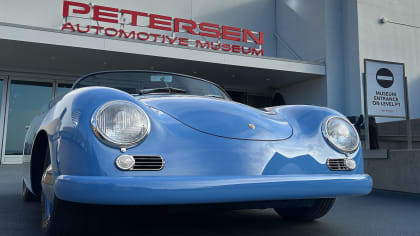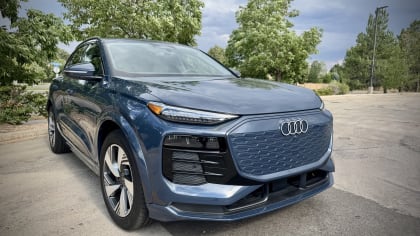KILLER CAR SOUND FOR CHEAPSKATES
This article is from our archives and has not been updated and integrated with our "new" site yet... Even so, it's still awesome - so keep reading!
Published on Sun, Aug 1, 2010
By: The LACar Editorial Staff

Bazooka BTA6250D
Can one get a high end car sound system on a shoestring budget?
By Roy Nakano
In 1989, Daniel L. Ferguson authored a manifesto for Audio Amateur Publications called, “Killer Car Stereo on a Budget.” In the manifesto, Ferguson claimed that the simple addition of a subwoofer to an otherwise standard factory sound system would put most car audio systems to shame.
The premise is counter-intuitive to what car owners might want to do in order to improve sound quality. Music lovers value the midrange, so it’s not unusual for car audio tinkerers to instinctively replace the drivers as the first order of business in improving sound. But matching the sound of new midrange drivers to the tweeters can be hit or miss. So it inevitably leads to the need to change tweeters. And since aftermarket drivers may have higher amplification demands, you might as well add an amplifier (or even an entirely new head unit) into the equation.
Ferguson’s premise is that a self-powered subwoofer with a built in crossover/dividing network obviates the need to go down the aforementioned slippery slope. Introducing this combination into an existing car sound system does two things. First, it allows the occupants to hear and feel a significant part of the music that’s missing in most systems—i.e., the bottom end. More importantly, the dividing network provides the midrange drivers some relief from the task to reproduce the bottom end of the music. This means that the midrange drivers are taxed less, reducing distortion, thereby ultimately improving the sound quality of the midrange.

Ken Kreisel and Jonas Miller at Jonas Miller Sound in the 1970s
THE HOME FRONT
Ferguson is not the first to advocate adding a self-powered subwoofer with a built-in crossover to improve the sound of an audio system. Much of the credit to popularizing subwoofer systems goes to Ken Kreisel and D. Jonas Miller, founders of Miller & Kreisel Sound Corporation (now known as MK Sound).
The impetus was spawned by Jonas Miller, who owned a well-known high end audio store in Beverly Hills (Jonas Miller Sound). Miller sought a solution to remedying the bass-deficient sound of the otherwise excellent electrostatic speakers he sold. The two brought in Lester Field, the former chief scientist and vice president of research at Hughes Aircraft Company, to design subwoofers for domestic application. A professor emeritus with expertise in acoustics at both Caltech and Stanford University, Fields designed the world’s first integrated satellite/subwoofer system, the MK David and Goliath in 1976. The next year, MK followed with the active (internally powered) subwoofer, the MK Servo Volkswoofer.
The resulting sound bordered on mind-boggling. The addition of an amplified subwoofer created a sound stage far larger that anyone would have imagined out of two tiny speakers. The sense of realism added by the MK systems created a ground swell of popularity for subwoofer systems.
Despite all the subwoofer activity going on in the home audio front, there were no car audio products that fit the recipe called for by Ferguson’s manifesto at the time of its publication. And so a good portion of the manifesto was devoted to the construction of a subwoofer-amplifier-crossover system for the car. That was then. Today, there are several car audio products that fit the Ferguson recipe right out of the box.

The Bazooka BTA6100 in a Prius
BREAKING THE SOUND BARRIER
LA CAR put the Ferguson premise to the test a few years ago in a Toyota Prius ("Project Prius: Breaking the Sound Barrier"). The Prius has many attributes, but good sound quality in the standard audio system is not one of them. We decided to take a $199 Bazooka BTA6100 self-powered subwoofer and match its built-in crossover with the standard sound system in the Prius.
The results were an ear-opener. The sound wasn’t just better. It was better than the Premium JBL audio system offered as an extra cost option in the Prius. We took the project car to Autobooks-Aerobooks in Burbank during an LA Car Day event, and held a sound system shoot out: Prius owners came by to pit their premium JBL systems against the lowly standard audio system in our project car with the subwoofer. One-by-one, the JBL systems were laid to waste, sonically slayed in dynamic range, midrange clarity and overall realism.

MINI Cooper S
BAZOOKA: ROUND TWO
To make sure what happened wasn’t just an anomaly, LA CAR decided to take a different car and a slightly different subwoofer system. In this second project, we used a 2010 MINI Cooper S with its rather mediocre-sounding standard audio system and mated it to a new subwoofer system from Bazooka: The BTA6250D, which uses a single 6-1/2 inch driver in a tube.
Like the BTA6100 used in the Prius, the BTA6250D has its own built-in amplifer and crossover network. The 6250D has frequency responses that go down to around 35 cycles per second (low enough to reproduce the lowest note of a stand-up acoustic bass instrument). Where the two significantly differ are in power output (100 watts for the 6100 and 250 watts for the 6250D—the latter incorporates Class D amplification), crossover range (fixed at 85 hertz for the 6100, variable from 80-250 hertz on the 6200) and price ($199.95 versus $269.95).
We stuck with Bazooka, because the brand has withstood the test of time. SAS is the company that popularized the Bass Tube™ subwoofer design (they hold the patent on it), and they’ve been developing, refining, and building the Bazooka subwoofer for several decades now.
One of the little-publicized beliefs held by some Bazooka specialists is that the smallest units with the 6-1/2 inch driver have the best bass articulation of the bunch—better than the more costly 8 and 10-inch units. The bigger units offer a bigger sound. However, if you’re after the cleanest bass reproduction, have a relatively small vehicle, and don’t have a need to really crank up the volume, consider one of the small Bazookas. For that reason, we stuck with the BTA6250D.

Al & Ed’s Autosound in East Pasadena
AL AND ED’S
So that readers can easily replicate our results, we sought out the participation of Al and Ed’s Autosound to handle the installation. As you probably know, there are virtually as many Al and Ed’s stores as Starbucks stores. And getting a triple shot espresso at the Starbucks in Santa Ana is pretty much identical to the one you’ll get at the Starbucks in Santa Clarita. We figure the same ought to hold true for Al and Ed’s—meaning you should be able to replicate our results at your neighborhood Al and Ed’s store.
With this notion in mind, we went to Robert Saracione’s Al and Ed’s store in East Pasadena, California. Located on the corner of Colorado and Rosemead Boulevards, Robert’s store has been a mainstay in the Pasadena community for decades, outlasting the Circuit City next door, and the Sound Factor across the street (the Sound Factor is moving). Despite the current recession, the neighborhood is about to get a serious shot in the arm, with the Circuit City store being replaced by a Sprouts Farmers Market (think Whole Foods Market) and a new Henry’s (think Trader Joe’s) opening down the street.
Robert had veteran installers Todd Newman and Frankie Samora on hand to complete the surgical implant of the Bazooka. The installation on the BTA6250D is a tad more complicated than the BTA6100, requiring the power to be hooked up directly to the engine compartment battery. The subwoofer feeds the musical signals from the MINI’s front channels. Completing the installation is an on/off switch connected to the car’s ignition, and a ground wire to keep unwanted noises to a minimum. Saracione’s team gathered all the cables and wires and housed them in a flexible accordion tube going to the Bazooka subwoofer.

L-R: Frankie Samora, Todd Newman, Robert Saracione, and Rockford Fosgate's Heath Lundsford
The techies at Bazooka are pretty particular about subwoofer placement, favoring corner loading whenever possible. In layperson’s terms, this means aiming the driver into one of the rear corners of the car. With the MINI, however, the trunk space is so small that placing the Bazooka subwoofer in practically any direction means the driver is already aimed pretty darn close to a corner. Since our MINI came with its own cargo net, placement under the net was an easy way to secure the unit—obviating the need to use the tie-down straps that come with the subwoofer.

Easily removable, the unit tucks neatly under the cargo net.
THE SOUND
So, how does the Bazooka-equipped MINI sound? A whole lot better than the standard stereo system, that’s for sure. Whereas the standard system is bass and volume deficient, the Bazooka-equipped system delivers substantially deeper bass and a bigger sound stage. Listening to “Julsång” off of Cantate Domino on the Proprius label, for instance, transforms the tight MINI passenger compartment into what sounds like a cathedral. This effect is also evident when playing live recordings, such as "Roxanne" off of Sting’s 2001 All This Time.
The bottom end on the Bazooka-equipped standard MINI audio system actually puts the $750 Harman Kardon option to shame. The HK has a pleasant enough sound, and it’s bass response does not seem deficient—until you compare it to the Bazooka-equipped system. The Bazooka subwoofer simply moves more air than the HK can’t touch.
The BTA6250D is even better than the BTA6100 in this regard. Jazz aficionados talk about a sound so clear that you can hear the rosin on the strings. While I won’t go so far as to say I can hear the difference between Pop's and Carlsson double bass rosin with the BTA6250D, you will hear more clarity and definition than with the BTA6100, or, for that matter, than the Harman Kardon premium sound system.
The improvements don’t stop at the bottom end, however. The Bazooka-equipped system sounds better throughout the midrange. With the BTA6250D crossover relieving the midrange drivers from having to reproduce the bass registers, distortion in the midrange is noticeably diminished. The overall result is a cleaner, more transparent midrange.
Alas, the treble (high frequency) response is virtually unchanged. The tweeters in the MINI tend to be highly directional, and this doesn’t change with the Bazooka-equipped system. Here, the optional HK system clearly does a better job.

THE BOTTOM LINE In the end, the Bazooka-equipped standard audio system is significantly better than the optional Harman Kardon system in some regards (the bass registers, replicating the scale of a large theater or cathedral). In other regards, the HK still reigns supreme (high frequency dispersion and transients). On the other hand, the HK sets you back 750 big ones. For the Bazooka, it’s $269.95 for the BTA6250D, plus the cost of installation. With wires, a power kit, and the cost of labor, installation should be under $200. If you go with the $199.95 BTA6100, the wiring is simpler and, consequently, the installation should be even cheaper. In either case, the total outlay undercuts the HK option by a substantial margin. Update: SAS began shipping its Testtubes Demo Tube Controller to dealers. The controller allows the dealers to place a Bazooka BTAxx100 Bass Tube™ in a customer’s car to let them readily hear the difference a subwoofer will make to their sound system. This will allow you to hear what you’ll get before you buy. The Key Players: Bazooka subwoofer supplied by Southern Audio Services, Inc. (SAS) (bazooka.com) Al and Ed’s Autosound (al-eds.com) Installation courtesy of Al and Ed’s Autosound's East Pasadena Store 3689 East Colorado Boulevard Pasadena, CA 91107 Telephone: 626-583-8700 SPECIFICATIONS Name of subwoofer: Bazooka BTA6250D Price: $269.95 Type: Tube cabinet, with Class-D amplified driver and built-in crossover. Power Output: 250 watts Sensitivity: 100dB Frequency Response: 35Hz-250Hz Fuse: 15 amp Inline Crossover: LP Max Power Output: 300 watts Power @ 4 OHM: 200 watts Power @ 2 OHM: 275 watts Dimensions Height: 8" Width: 6.750" Length: 18.5" Battery Voltage Range: 10.5-14.4 vdc Remote Control: RBCM-250D optional RCA Input: yes Hi Input Level: yes Crossover Range: 80-250 Hz Subsonic Filter: no Voice Coil Size: 1.5" High power / High temp




